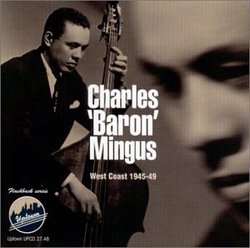Superb reissue of important recordings
madamemusico | Cincinnati, Ohio USA | 07/14/2002
(4 out of 5 stars)
"This excellent compilation gives us most of the sides made by Charles Mingus under his own name (and a few under others' names) during his long and often frustrating period in California, the 1940s. The reason I only gave it four stars is that, while some of the music is indeed superb and up to his normal high level, we also hear him struggling with compromises to commercialism (such as four takes of a dog of a tune, "Baby Take a Chance With Me," in which only the bridge shows traces of the Mingus style). Nevertheless, the good tracks are very good indeed and point to the more mature style to come in the early-to-mid 1950s. Even better is the booklet, with its fascinating details, rare photos and record labels that makes you feel as if you had purchased a treasure-trove instead of simply a historical jazz CD. If you love jazz and its evolution from a purely improvised music to one in which writing plays an important part, Mingus was certainly a giant in his field and this is a very important part of his story."
Ultra Rare Early Recordings By Charles Mingus
Ron Frankl | Hendersonville, NC | 03/15/2001
(4 out of 5 stars)
"Composer/bassist/bandleader arrived in New York in the early Fifties after stints with Lionel Hampton and Red Norvo, seemingly a multi-talented and fully-formed musician. Unknown to most was that the musician had a long career in Los Angeles bands dating back to the early Forties. Remarkably, the many recordings that Mingus made in L.A. in the mid-Forties have not been reissued, at least until this historic collection.Given the minuscule size of the record companies for which he recorded, perhaps it's a miracle that these sides survived at all. Mingus led his own group on most of these sessions, which featured mostly originals compositions. Amazingly, Mingus was already composing unusually complex and ambitious works that reflected some of the harmonic development of the then-current bebop movement, yet the music itself cannot be classified as bebop. Instead, Mingus seems to be exploring the implications that bebop harmonies could have on jazz composition. Tadd Dameron and Miles Davis, among others, would pursue similar ideas in the late Forties, but Mingus, as usual, seems to be moving in his own individual direction.Given Mingus' musical background, his individualistic approach to jazz composition is hardly surprising. Classically trained, Mingus was writing classical/jazz hybrids even as a teenager. In a more racially tolerant era, he would almost certainly have pursued a career as a classical cellist or composer. Fortunately, jazz gave him a forum to pursue his musical aspirations. These seminal recordings are an intriguing peak at his ability to wed jazz harmonies, instrumentation and rhythms to classically-influenced musical forms. His ambitions were enormous, perhaps only exceeded by Duke Ellington among jazz musicians. If Mingus could be accused of inconsistency in his music, he could never be accused of complacency. That said, these early works are not the equal of his classic recordings of the mid to late Fifties. Some of these tracks feature vocalists, in an obvious if unlikely attempt at a hit record, while other numbers are interesting experiments at best. Still, it's a revelation to hear so many elements of Mingus' later style already at work in his music. Every serious fan of Charles Mingus will want to hear these recordings, and the compilers of this set have done a magnificent job. The CD comes with an extraordinary booklet."
Fascinating Early Mingus Music
dls31@cornell.edu | Washington, DC | 03/06/2001
(5 out of 5 stars)
"This disc features the early work of one of jazz's greatest composers, Charles Mingus. The tracks offer a variety of early Mingus tunes, including a few that became Mingus standards. However, the real jewel here is the lovingly detailed 96 page liner notes, which tell you everything you ever wanted to know about early Mingus, with photos to boot: learn while you listen. Hear one of jazz's great minds begining to take shape. Catch Mingus's work back in the days when he was a relative unknown with the self-imposed moniker, Baron. Highly recommended."


 Track Listings (24) - Disc #1
Track Listings (24) - Disc #1